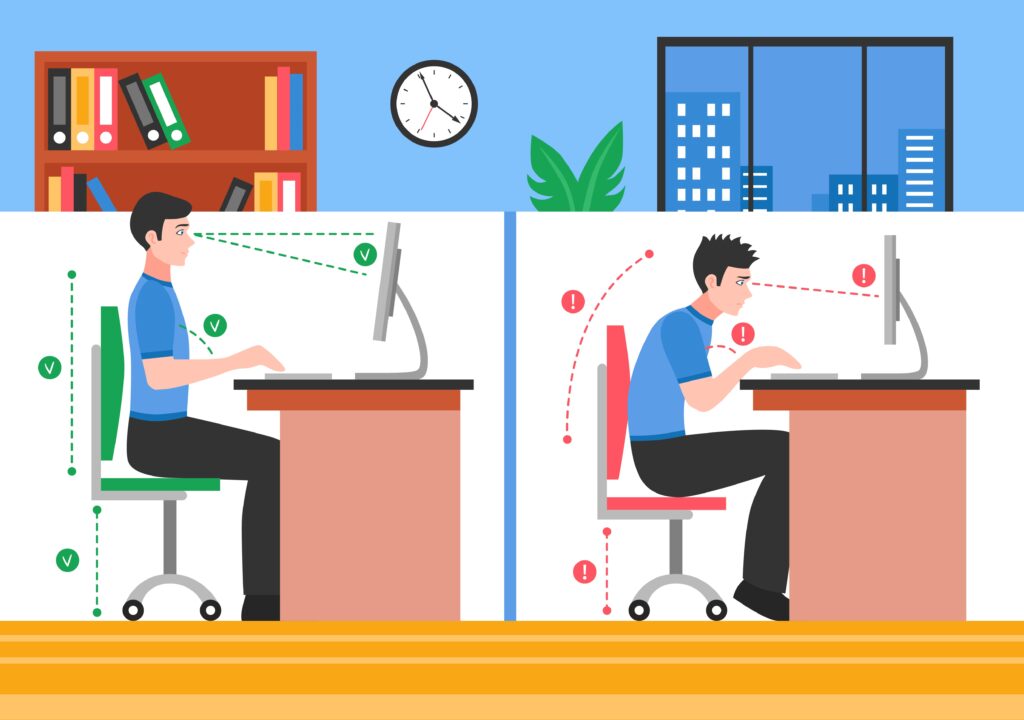Back pain prevention takes practice and patience. Thanks to technology and shifting attitudes toward work-life balance, remote work has become a viable option for an ever-increasing number of employees across various industries. However, with the freedom and convenience of remote work comes a set of challenges. Its sedentary nature has led to a surge in musculoskeletal disorders, especially back pain.
In this blog, we will explore the unique challenges faced by remote workers, delve into the importance of ergonomic home office setups, discuss the benefits of maintaining a routine, and offer practical tips for incorporating movement for back pain prevention.
The Challenges of Remote Work
The absence of proper ergonomic office setups, long hours spent sitting, the stress and anxiety associated with tight deadlines, virtual meetings, and an “always-on” mentality can contribute to tension and increased strain in the back muscles.
Ergonomics is essentially the science of tailoring our workspaces to suit the natural alignment of our bodies. You could think of it as a ‘back pain prevention strategy’, safeguarding our long-term well-being.
A well-designed ergonomic workspace ensures that your environment adapts to your body. It minimizes the risk of poor posture – a major culprit in musculoskeletal discomfort.
Tips for Setting Up an Ergonomic Space
- Set your chair and desk at the right height to maintain good posture. Your arms should rest comfortably parallel to the ground when typing.
- Your monitor should be at eye level. Position your keyboard and mouse close enough to avoid overreaching.
- Invest in a chair that provides proper lumbar support or consider using a lumbar cushion to maintain the natural curve of your lower back. Additionally, ensure that your seat is comfortable and padded.
- Back pain prevention makes standing desks an excellent option for those who wish to alternate between sitting and standing during the workday. Ensure your screen and accessories remain at the same ergonomic height.

Maintaining a Routine
Remote work offers flexibility, but without a structured routine, it can easily lead to irregular habits and, eventually, back pain. Here’s why maintaining a routine is crucial in back pain prevention:
- Emphasize the importance of structure in remote work:
Remote work often lacks the structure that a traditional office job provides. While flexibility is a significant perk, it can sometimes lead to overworking, inconsistent schedules, and a blurred work-life boundary. Creating and adhering to a routine can help address these issues. - Setting a consistent work schedule:
One of the first steps in maintaining a routine is setting a regular work schedule. Determine your work hours and stick to them as closely as possible. By doing this, you establish boundaries between work and personal life, reducing the risk of prolonged sitting and overworking. - Scheduling regular breaks and stretching sessions:
Incorporating short breaks throughout your workday is essential for back pain prevention. Aim for a 5-10 minute break every hour. During these breaks, stretch your legs, perform some quick desk exercises, or simply stand up and move around. These mini-breaks can relieve tension in your back and muscles. - Time management techniques to prevent overworking:
Remote workers often struggle with overworking due to the lack of clear boundaries. Implement time management techniques like the Pomodoro technique, which involves working in focused intervals followed by short breaks. This boosts productivity and ensures you take regular breaks to stretch and rest your back.
Incorporating these strategies into your daily routine can significantly contribute to back pain prevention. Consistency in your work schedule, regular breaks, and effective time management create a healthier work environment that prioritizes your back health.
Incorporating Movement into Remote Workdays
Counteract the negative consequences of desk-bound work and promote a healthier spine. To do so, integrate regular movement into your remote workdays.
One effective strategy for combating the effects of prolonged sitting is to schedule short, frequent movement breaks throughout your workday. Aim to stand up, stretch, and move around every 30 minutes to an hour. These breaks not only provide relief to your back but also boost overall productivity and well-being.
Consider setting reminders or using productivity apps to prompt you to take these breaks. Even a quick walk around your workspace or a few moments of stretching can go a long way in back pain prevention and maintaining good posture.
Simple exercises and stretches are of great help. These can be performed during short breaks or whenever you feel tension building up:
- Shoulder Rolls: Gently roll your shoulders backward and forward to release tension.
- Neck Stretches: Tilt your head from side to side and forward and backward to ease neck strain.
- Seated Leg Lifts: Lift one leg at a time while sitting to engage your leg muscles.
- Seated Cat-Cow Stretch: Arch your back like a cat and then arch it in the opposite direction like a cow.
- Seated Spinal Twist: Twist your upper body gently to the left and right while holding onto the back of your chair.
If you have access to a standing desk or an adjustable workspace, switch to a standing position during audio-only conference calls.
These simple practices not only prevent stiffness and discomfort but also help improve posture, making them essential components of a healthy remote work routine.
Conclusion on Healthy Remote Work Practices
As remote workers, we must recognize that our well-being is invaluable. Implementing ergonomic practices, incorporating movement into our workdays, managing stress, and seeking support when needed will safeguard our back health. It’s an investment in your long-term health and productivity.
For further resources about back pain prevention, consider the following:
[Link to a chiropractic clinic offering services that address musculoskeletal disorders]
[Link to an online fitness platform offering virtual exercise classes]

